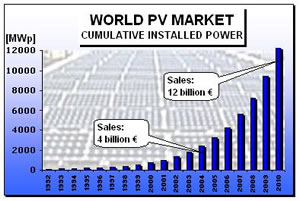Global PV market growth faced with price increases

|
Global PV market growth faced with price increases |
|
2004 saw the continuation of the rapid growth in the global
solar PV market. Cell production increased by 67% and the level of cumulative
installed PV power rose by 30%. In spite of this, market demand continues to
exceed supply! The elation brought by this continuing success is being dampened
by the current shortage of PV modules and the resulting price increases. This
phenomenon applies not only to modules but also to the manufacturers and
suppliers. It is now a case of ‘find and be found’ in this type of market
environment, which is why we are highlighting the Trading Floor and the market
directories in this third edition of the SUN.
The module shortage can not be attributed to the global module production
capacity. New module production facilities are opening up at an incredible rate
and there are already over 200 companies manufacturing PV modules. The problem
is found higher in the distribution chain where a shortage of silicon feedstock
for the solar industry has been identified. A lack of silicon is hindering the
production of wafers, solar cells and modules. Investment in solar silicon
production plants has failed to keep pace with the continued market demand for
solar cells and modules. New silicon plants require high investment and as such
can only be viable for specialized industrial companies. Industry experts
foresee the current growth in available silicon for the solar industry will not
be able to match the growth in the market demand for solar cells and modules
until 2007. This will inevitably result in price increases in the supply chain
leading ultimately to higher module prices for the consumer. These price
increases could increase in a loss of consumer interest especially when coupled
with the planned annual reduction of the payback rates, as is the case in
Germany. This development may stabilize supply and demand, however the
inevitable increase in silicon production may have a more serious effect as this
could lead to a surplus of solar cells and modules. It is quite possible that
this surplus could result in sharp falls in PV module prices. This situation
would make it extremely difficult for the smaller module manufacturers to
compete with the large module manufacturers. This can only be avoided by
entering new markets and with the introduction of new attractive module and
system prices. Furthermore, who is able to predict oil price changes and global
political situations for the coming years? One thing is certain, the PV market
is still in its infancy and will remain dynamic for the next years, it is
therefore vital for the market players to stay tuned!